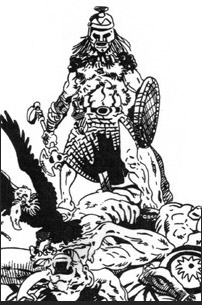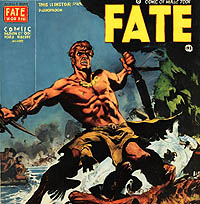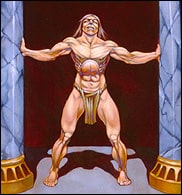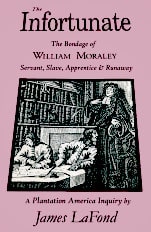Over a hundred years ago a novelist, Harold Lamb, wrote three historical novels with a great impact on pulp fiction: Alexander [a book I read for my 9th grade history report], The Wolf Chaser, a novel of Genghis Khan, and Tamerlane: Conqueror of the Earth. Robert E. Howard's superb, Lord of Samarkand was based on and inspired by the latter. [0]
Lamb sketches an introduction which states that historians had done what clerical work could be done on Tamerlane from existing sources. Lamb is as good an historian as any of his many sources. In addition, his novelist’s knowledge of human nature, a thing that most academics are unversed in, armed him with the ability to find Tamerlane, the character, the man, the Sphinx of War.
His name was Timur, which means “Iron.” While serving a minor king as a volunteer, a king who would one day be his vassal, he was shot in the foot with an arrow and forever limped. His enemies then called him Timur-the-lame, and so he came to be known by the backwards men of Christendom, who held God far from their heart and gold close, even as the Arabs and Turks had pushed them until their backs were to the sea.
Timur was the son of a minor chieftain, who dedicated his life to the Mosque and learning in Islam after Timur’s mother died. Timur started upon his “one path,” with four friends as followers, and by acts of heroism and an absolute generosity to women, children, vassals and especially soldiers, conquered more lands under his own hand than Genghis Khan, whose title he declined to seek. Leading from the front like Alexander had, he lacked the thing that Phillip had left his son; for Alexander had the best army of his world handed to him. Ten years older than Alexander was when he died, Timur was still leading from the front, having recreated the Mongol army from its scattered scraps.
Timur was one of the strongest men alive. His men drew their long bow to the chest, where he drew it to the ear. Our idea of the Mongols all drawing to the ear may come from such few men doing it and having their draw immortalized in art. Timur had a simple love of freedom combined with a love of his country, the sector around Samarkand in Central Asia. These emotions, his only it seemed, were expressed in the need to conquer the remnant Mongol hordes that kept his home in peril and poor. Once he had done this, his desire to have his city prosper and become great and sustaining expressed in alliances with and conquests of some 25 adjacent kingdoms. These actions resulted in him making two great enemies, The Golden Horde and the Ottomon Turks, the two powers with their boots on the collective necks of Christendom.
He defeated Christians that attacked him or stood in his way, like the Knights of Saint John and Georgians. [2] But most of his ire was vented against impious Muslims—his wars were almost entirely against Muslims [who regarded his Tartar people as “half-pagan]” and his pagan cousins, the Mongols. The Imans claimed him, the Muslim Chroniclers extolling him as the Sword of Islam. Yet he never took the Muslim title Gaza for holy warrior king nor any other Islamic honorific, declining to make war on Hindus or Christians unless they got in his righteous way.
Timur saved Europe from losing everything east of the Alps and freed Russia from the Mongol Yoke, without even a care, simply by avenging insults, betrayals and challenges. Until his seventieth year he took the saddle annually to make certain that trade could flow through Samarkand from China and India, through the Near East and into Europe.
He loved his soldiers and lost his best warrior sons in battle. In his last campaign, marching through the blizzards of Central Asia to subdue China, most of his Lords were the sons and grandsons of the men who had originally rode with him. He was smarter by half than all kings that opposed him and collected scientists like a child does toys, settling them in his beloved city, which he rarely visited.
Timur’s most similar soul in the saddle was Nathan Bedford Forest. Indeed, Timur’s famous axiom that it is better to arrive on time with ten men then arrive late with ten thousand is echoed in Forest’s “the first with the most” dictum. Timor followed three rules of war:
-Never fight in one’s own country.
-Never defend.
-Always attack.
His favorite soldiers included a giant with an iron shield who had no followers and had a great bow no one else could bend. He was in a tavern when the hetman of the village informed him that 40 Persians had ridden into town and he should flee. He commanded the hetman to gather his 20 men, mount horses and follow him to the charge upon the enemy, that Persians were mere jackals.
His men deserted him and he drove off the Persian alone, noting that jackals though they may be, at least they were not villagers!
He would later take the citadel of Alamut, stronghold of the Hashisans, single-handedly, by climbing a cliff and roaring down with sword. This character is as Conanesque as Forest, and certainly inspired Howard in the creation of the giant Barbarian.
Timur ruled utterly alone. He considered advice but never had planning discussions. [3] He made decisions in his silent brooding genius mind and then gave orders, his men competing to equal the task set before them. This meant that he came and went like a force of nature, welding together the best army in pre-modern history, as good as the mongols and larger. When he died on the road to China and he summoned his lords for instructions not to quarrel, he spit into the wind. He did not build a monstrous government like Augustus or Diocletion or George Washington and his co conspirators. He simply applied a razor sharp mind and a will of iron to make for the homeland he rarely rested in, a generation in the sun.
With his death it all blew in the wind. Yet, his great grandsons would be great rulers, to include Akbar, the greatest Mogul Emperor, the most religiously tolerant emperor of the Monotheistic Age, saving Timur.
Was no title good enough for Timur?
Or, did he know that he had been cast as an instrument of punishment upon the greatest and most cruel kings of the earth?
Lamb’s wonderful narrative ends with an hour of source notes. This excellent dissertation on various questions concerning Timur, ends with the author quoting his Subject, from a document signed with his own hand [1] and sent to his “Son” the King of Castile. In this passage the author lets this reader know where he found Timur the man, who addressed his letter from, “I, Timur, Servant of God.”
…
Notes
-0. Lamb actually examined Mongol antiquities in China, at Peking.
-1. One Arab scholar, who had been Timur’s slave, who hated him and declared him a pagan, also noted that he was “just,” “powerful” in build, “long limbed” and “large headed,” and… “white,” of complexion.
-2. Italian merchants who controlled the sea lanes helped the Ottomons but not Timur, and would eventually help the Ottomons come back against Constantinople.
-3. Obsessed with chess, he invented a double board with double spaces and pieces.











“Ten years older than Alexander was when he died,”. Really?
Alexander died at 33; Tamerlane at 69. My math says that is more than ten years.
"Ten years older than Alexander was when he died, Timur was still leading from the front, having recreated the Mongol army from its scattered scraps."
At 43, indeed up to about 50, Timur was leading from the front. That is 10 plus years. One episode near to 60 years he sat in the saddle under the battlements of a city he threatened and demand a duel with the king, whose mean could have slain him, but did not. In his 20s, when Alexander was conquering, Timur was being hunted.
Thanks, sorry for the murky wording.